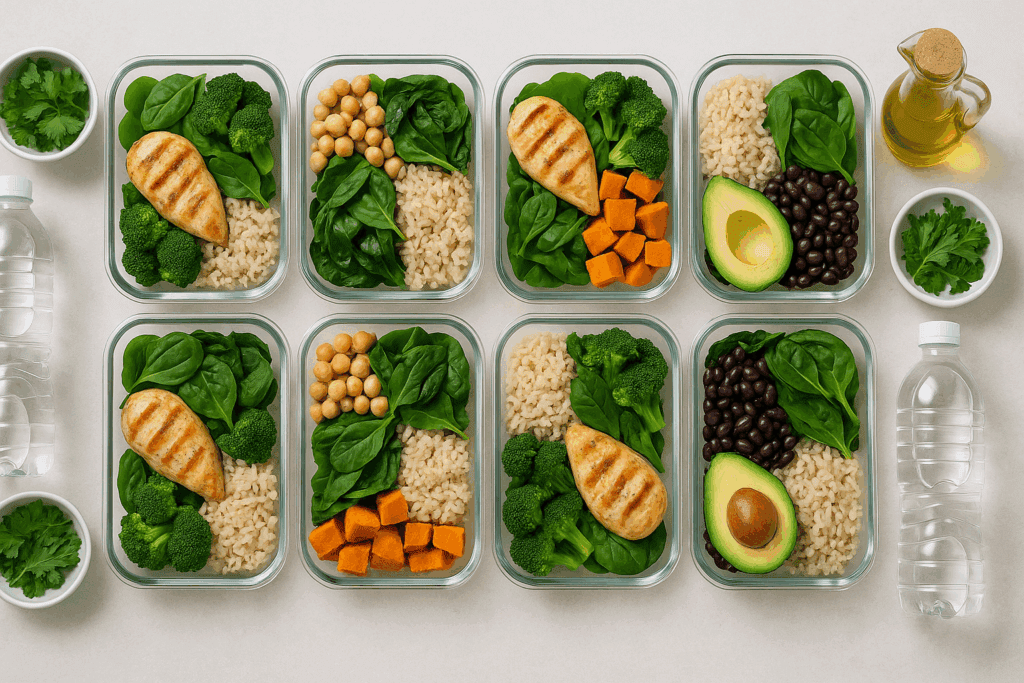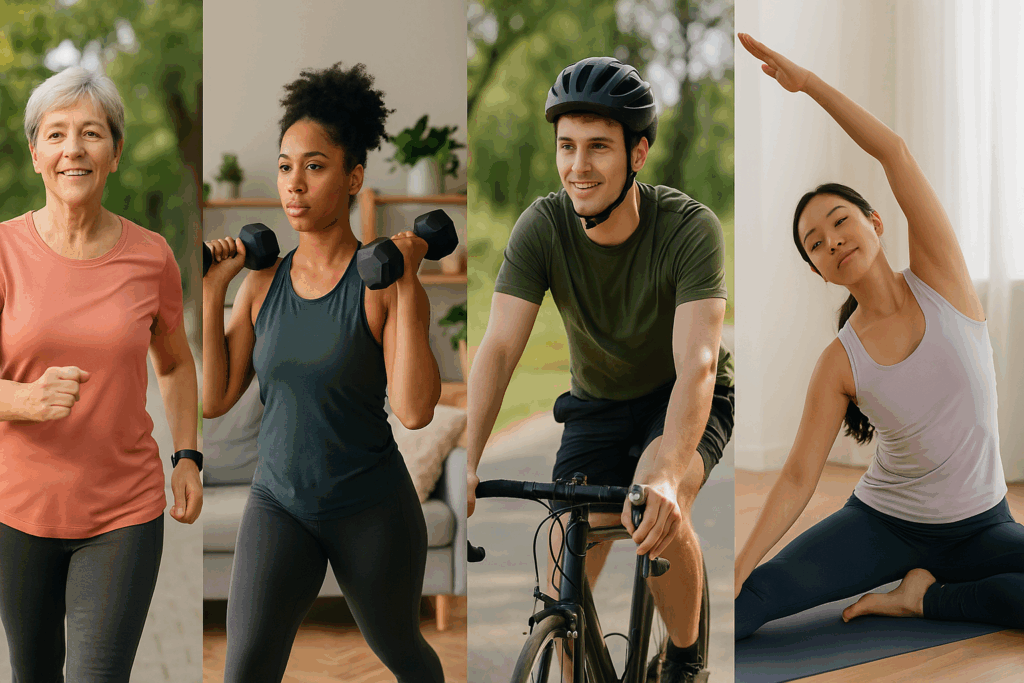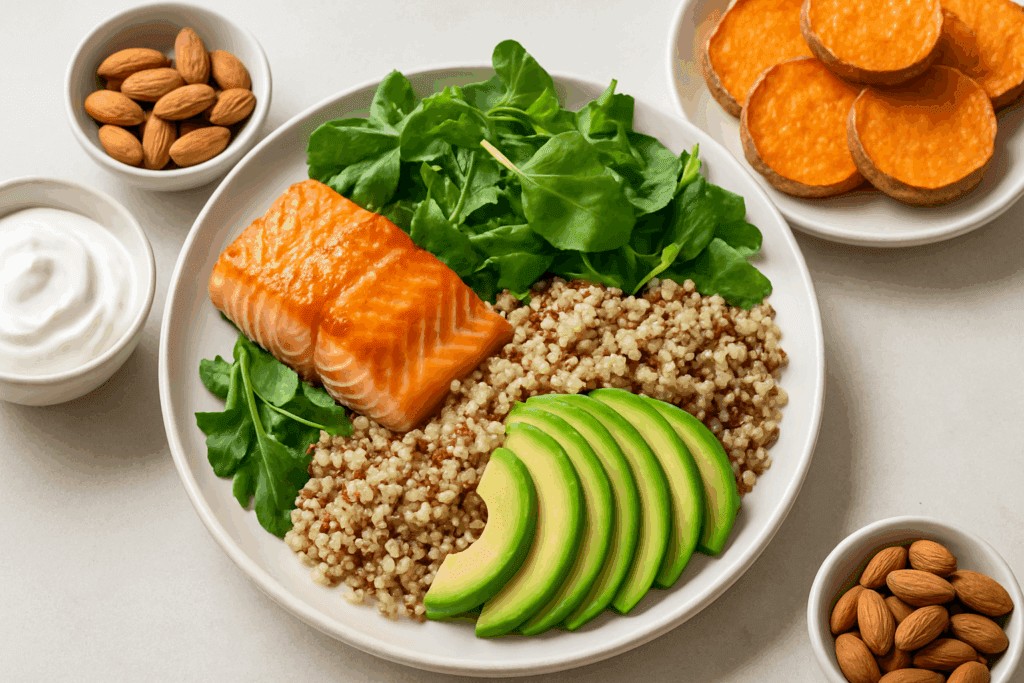Introduction: Why 30 Days Can Make a Real Difference
Losing weight is a deeply personal journey, often fraught with conflicting advice, short-term fads, and unrealistic promises. Many people find themselves asking how to lose weight in 30 days in a way that is safe, sustainable, and supported by medical professionals. The good news is that safe and effective weight loss in a thirty-day timeframe is not only possible—it’s achievable through evidence-based strategies, nutritional balance, and a realistic commitment to behavior change. This article offers a medically grounded, reader-friendly exploration of how to lose weight in thirty days, with a particular emphasis on the role of a 30 day meal plan for weight loss and the kinds of foods that truly make a difference.
You may also like: Expert-Backed Weight Loss Tips for a Healthier Lifestyle: What You Need to Know for Long-Term Weight Control and Wellness
The Power of Personalized Nutrition
Rather than offering a one-size-fits-all solution, understanding how to lose weight fast in 30 days requires a personalized approach that begins with recognizing your body’s unique metabolic needs. While many associate rapid weight loss with deprivation or extreme exercise, the science points toward moderation, consistency, and lifestyle alignment. A month is enough time to reset habits, reduce unhealthy fat stores, improve insulin sensitivity, and boost cardiovascular markers. But it must be done wisely. Doctors emphasize that losing weight in one month should focus on fat loss rather than water weight or muscle wasting, which often occurs in crash diets.

Building a Balanced 30 Day Meal Plan for Weight Loss
The foundation of any successful 30 day weight loss strategy is grounded in nutrition. While exercise is a powerful complement, diet exerts the most influence over weight change. The idea of a 30 day meal plan for weight loss isn’t new, but the approach needs to shift from calorie counting alone to nutrient density. That means focusing on whole foods rich in fiber, protein, healthy fats, and phytonutrients. Think leafy greens, legumes, whole grains, lean proteins like chicken or fish, and healthy oils such as extra virgin olive oil.
How Consistency and Structure Promote Results
One of the key reasons people fail to lose weight in thirty days is the lack of a consistent routine. Willpower fades quickly, but structure endures. Implementing a predictable, doctor-approved eating pattern—such as intermittent fasting or time-restricted feeding—can enhance metabolic flexibility. When paired with a well-balanced 30 day weight loss meal plan, the result is improved fat burning and appetite control. Importantly, fasting strategies must be used wisely and under guidance.
Eating Enjoyably Without Feeling Deprived
But how can you lose weight in 30 days without falling into the trap of overly restrictive dieting? The key lies in finding pleasure in healthy food. Flavorful meals that include herbs, spices, and satisfying textures not only improve satiety but reduce the psychological feeling of deprivation. A 30 day weight loss plan doesn’t have to feel like punishment. When food tastes good and leaves you feeling energized, it becomes easier to stay the course.

The Importance of Hydration in a 30 Day Weight Loss Plan
Hydration plays an often overlooked but essential role in any plan to lose weight in one month. Water helps regulate body temperature, supports digestion, and most importantly, aids in cellular metabolism. Studies show that drinking water before meals can promote satiety and reduce overall caloric intake. Herbal teas, such as peppermint or ginger, are also helpful for digestion and can replace calorie-laden beverages.

Exercise and Movement: Accelerating Fat Loss Safely
Exercise, while not the primary driver of weight loss, enhances the results of dietary changes and improves body composition. For those wondering how to lose weight fast in 30 days, combining aerobic workouts with strength training is key. Cardiovascular activities like brisk walking, cycling, or swimming burn calories and improve heart health. Meanwhile, resistance exercises build lean muscle, which increases basal metabolic rate.

Managing Stress, Sleep, and Emotional Triggers
The psychological dimension of weight loss cannot be overstated. Many people attempting to lose weight in thirty days underestimate the impact of stress, sleep, and emotional triggers. Elevated cortisol from chronic stress can lead to weight retention. Similarly, inadequate sleep—defined as less than seven hours per night—disrupts hunger hormones and leads to increased cravings. Mindfulness techniques, journaling, and even therapy can support emotional regulation.

Tracking Progress Beyond the Scale
Monitoring progress during a 30 day weight loss journey is important, but it must go beyond the scale. Many people get discouraged when the number doesn’t budge, not realizing that changes in body composition—such as reduced waist circumference or improved muscle tone—may not immediately reflect in weight. Doctors recommend tracking energy levels, digestion, sleep quality, and mood as part of a holistic assessment.
Smart Portion Control and Meal Timing
Meal timing and portion control are practical tools that empower people trying to understand how can you lose weight in 30 days without extreme restrictions. Eating at regular intervals—say, every 4–6 hours—helps prevent blood sugar dips that lead to overeating. Smaller, balanced meals containing a mix of protein, fat, and fiber keep insulin levels stable and reduce the likelihood of cravings.
The Role of Support Systems in Weight Loss Success
Support systems enhance success in nearly every health endeavor, and 30 day weight loss is no exception. Accountability partners, online communities, or even professional coaching can provide motivation and structure. Sharing goals with a friend or family member often increases commitment. Social connection also counters the isolation that sometimes comes with dietary change.

Foods That Boost 30 Day Weight Loss Naturally
A medically sound 30 day meal plan for weight loss includes a variety of nutrient-rich foods that support metabolism and satiety. Breakfast might include a vegetable omelet with avocado, while lunch could feature a quinoa salad with chickpeas. Dinner may be a salmon filet with roasted Brussels sprouts and sweet potato. Snacks like Greek yogurt, almonds, or fruit with nut butter offer balance without excess sugar.
Superfoods, Spices, and Digestive Allies
While there is no magic food that causes weight to melt away, certain ingredients can enhance the effectiveness of a 30 day weight loss plan. High-fiber foods like chia seeds and lentils improve digestion. Fermented items like kefir and sauerkraut support gut health. Green tea, known for its catechin content, has mild thermogenic effects and may support fat metabolism. Spices like cinnamon and cayenne pepper can help regulate blood sugar and stimulate digestion.
What to Avoid for Optimal Weight Loss Results
It’s equally important to understand what to reduce or avoid during a 30 day weight loss challenge. Sugary drinks, including sodas and fruit juices, offer empty calories and spike insulin levels. Processed snacks and baked goods often contain refined flour and trans fats. Alcohol adds unnecessary calories and impairs judgment and sleep. Limiting these substances can dramatically improve results.
Beyond the 30 Days: Sustaining Your Weight Loss Success
As the 30 day mark approaches, it’s natural to wonder whether the changes made will last. The answer lies in the mindset cultivated throughout the process. Approaching this not as a temporary fix but as a lifestyle reset can yield far more meaningful results. Cooking at home, prioritizing whole foods, drinking more water, managing stress, and moving your body consistently are the building blocks of sustainable health.
Safety First: When to Seek Professional Guidance
Even after a successful month of weight loss, the journey doesn’t end. Maintenance requires a shift in focus—from restriction to rhythm. Transitioning from a structured 30 day weight loss plan to a long-term lifestyle requires evaluating what strategies worked best and which habits brought the most satisfaction. It also involves anticipating potential pitfalls and building safeguards. If weight loss efforts involve dizziness, extreme fatigue, or disordered eating patterns, it’s essential to seek professional help.
Frequently Asked Questions: How to Lose Weight in 30 Days Safely
1. What is the most overlooked factor when trying to lose weight in thirty days?
One of the most underestimated factors in a successful 30 day weight loss journey is the role of digestive health. A poorly functioning gut can interfere with nutrient absorption and lead to chronic inflammation, both of which slow down weight loss. Adding probiotic-rich foods like kimchi, kefir, and miso to your 30 day weight loss foods can enhance microbiome balance and promote more effective fat metabolism. Gut health also affects mood and hunger signals, which indirectly influences how to lose weight in 30 days by minimizing cravings and emotional eating. Prioritizing gut function as part of your overall strategy to lose weight in one month can significantly enhance your results.
2. Can you still follow a 30 day weight loss plan while eating out or traveling?
Yes, with the right preparation and awareness, you can stick to your goals even when dining out or traveling. Planning ahead by reviewing menus online and choosing restaurants with whole-food offerings can help you maintain a balanced approach. Opt for grilled over fried items, choose water or unsweetened tea instead of soda, and prioritize lean proteins and vegetables. The key to how to lose weight in 30 days while on the go is to maintain portion control and avoid mindless eating, especially during long trips. Creating a portable version of your 30 day meal plan for weight loss can keep you consistent without sacrificing flexibility.
3. Are there any psychological tools that support weight loss in one month?
Absolutely. Mental strategies are often the missing link for those trying to lose weight in thirty days. Techniques such as cognitive behavioral therapy (CBT) and mindfulness-based eating practices have shown significant promise in improving dietary adherence and emotional control. Journaling your meals, mood, and hunger levels can uncover patterns that sabotage your 30 day weight loss progress. Visualization exercises, such as imagining yourself completing the month feeling lighter and more confident, can reinforce motivation. These tools make a difference in how to lose weight fast in 30 days without falling into self-sabotage or burnout.
4. How can hormones impact a 30 day weight loss plan?
Hormones play a pivotal role in weight regulation, and imbalances can make it much harder to lose weight in one month. For instance, elevated cortisol levels from chronic stress increase fat retention around the midsection, while imbalances in thyroid or insulin can slow metabolism. Women may also notice shifts in appetite and weight during different phases of their menstrual cycle, requiring a more adaptive approach. Understanding how to lose weight in 30 days sometimes involves working with a healthcare provider to evaluate hormonal health. When managed effectively, hormone balance can optimize results from 30 day weight loss foods and exercise.
5. What’s the best way to adjust a 30 day meal plan for weight loss if you have food allergies?
Customizing your 30 day meal plan for weight loss to accommodate allergies is completely feasible and often necessary. If you’re allergic to common staples like eggs, dairy, or nuts, it’s essential to substitute with nutritionally equivalent alternatives. For instance, flaxseed meal can replace eggs in many recipes, while coconut or oat milk can stand in for dairy. Making these substitutions ensures you still receive the vital macronutrients and fiber necessary to lose weight in thirty days. A food sensitivity test may also help identify hidden intolerances that are disrupting your efforts in how can you lose weight in 30 days.
6. Is it possible to follow a vegetarian or vegan 30 day weight loss plan effectively?
A plant-based 30 day weight loss plan can be highly effective when well-structured. The emphasis should be on whole, unprocessed plant foods such as legumes, tofu, seeds, and a variety of colorful vegetables. These foods are naturally low in calories and high in fiber, making them ideal for anyone asking how to lose weight fast in 30 days. However, it’s important to ensure adequate intake of protein, iron, and B12—especially for vegans—using fortified foods or supplements as needed. When executed mindfully, a vegan approach can meet all nutritional needs and help you lose weight in one month sustainably.
7. Are there any specific 30 day weight loss foods that can target belly fat?
While no food can selectively burn belly fat, certain ingredients support processes that reduce central adiposity. Foods rich in omega-3 fatty acids, such as salmon and chia seeds, help combat inflammation that contributes to abdominal fat storage. High-polyphenol foods like green tea, blueberries, and dark chocolate support better insulin sensitivity, which also impacts belly fat. Adding these strategically into your 30 day meal plan for weight loss can accelerate fat reduction in stubborn areas. Understanding how can you lose weight in 30 days involves choosing functional foods that influence hormones and metabolic efficiency.
8. How can technology assist in a 30 day weight loss challenge?
Modern tools can significantly enhance your efforts to lose weight in thirty days. Wearable devices like smartwatches can track activity levels, heart rate, and even sleep quality, helping you optimize performance. Mobile apps for calorie tracking, hydration reminders, and mindful eating prompts can provide structure and accountability. Virtual personal trainers and telehealth dietitians offer customized advice that supports your unique needs during the 30 day weight loss process. Technology enables real-time feedback, which can be particularly motivating for those figuring out how to lose weight in 30 days with a busy schedule. When used wisely, these tools can bridge the gap between intention and action.
9. What are the long-term benefits of committing to a 30 day weight loss strategy?
The most profound benefits often extend well beyond the initial 30 days. Aside from visible weight reduction, many people report improved energy, better sleep, reduced inflammation, and greater confidence. The habits built—such as meal prepping, daily movement, and mindful eating—can evolve into permanent lifestyle changes. For many, learning how to lose weight in 30 days serves as a catalyst for broader wellness transformation. These improvements may also lower long-term risks for chronic diseases like diabetes and cardiovascular conditions.
10. What if the scale doesn’t move after 30 days?
Lack of scale movement does not necessarily mean failure. Weight can fluctuate due to water retention, hormonal changes, and muscle gain. Instead of relying solely on weight, assess other indicators like reduced bloating, improved skin, more restful sleep, and better digestion. You may still be losing inches or reducing visceral fat, which are harder to track with a simple weigh-in. If you’re following your 30 day meal plan for weight loss consistently and staying active, trust that progress is happening, even if it’s not immediately reflected in pounds lost. The path of how can you lose weight in 30 days often involves non-scale victories that signify genuine health improvements.
Conclusion: Reclaiming Health Through a 30 Day Weight Loss Journey
In conclusion, the quest to lose weight in thirty days safely is not about shortcuts or fads. It’s about aligning your actions with your health values, trusting the body’s natural intelligence, and making informed, sustainable choices. The journey begins with a decision—to care for your body in a way that supports energy, confidence, and longevity. A well-designed 30 day meal plan for weight loss, rooted in real food, science-backed strategies, and consistent daily habits, is the bridge between where you are now and where you want to be.
By understanding how can you lose weight in 30 days without extremes, you lay the foundation for success that extends well beyond a single month. This isn’t just about the number on the scale—it’s about reclaiming your health, reestablishing trust in your body, and realizing that sustainable weight loss is not just possible, but profoundly empowering when done the right way.
Further Reading:
Simple 30-Day Plan for Weight Loss, According to a Dietitian
The Ultimate 30-Day Shred Diet Plan For Fitness And Physique


